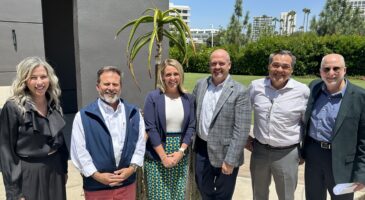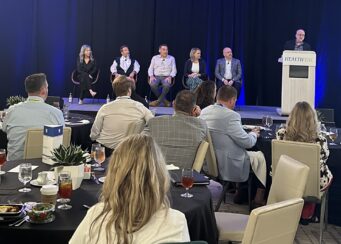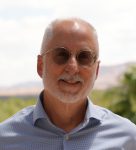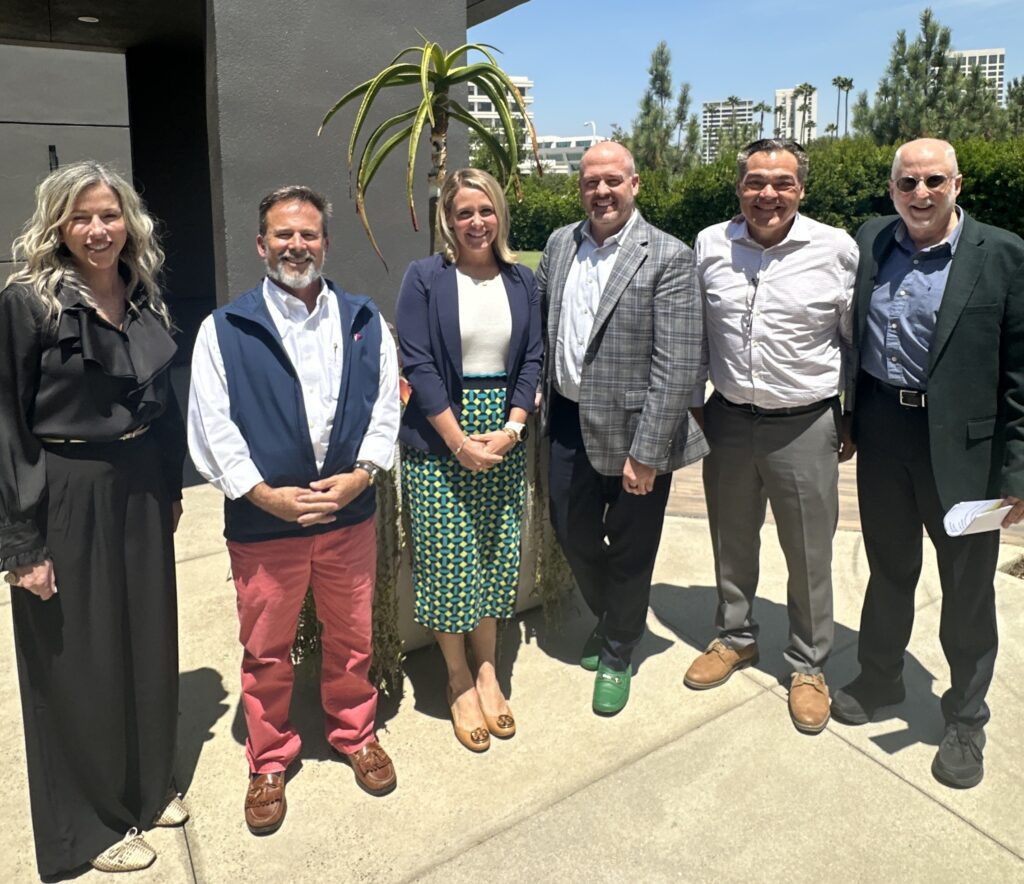By Jim Nelson | October 24, 2025

NEWPORT BEACH, CA — Each year, HEALTHTAC and Senior Living News throw a couple of boutique executive events, one on the east coast and one on the west coast. Among the team building and relationship starting, we always have a few panel discussions. This year at our west coast event, we engaged in a panel that dove into the importance of company culture.
In part 1 of this article, the panelists — Jake Quigley, the senior vice president of operations for Benchmark Senior Living; Dawn Blankenship, the regional director of operations for Sunshine Retirement Living; Operations Specialist Becky Janeczek from Northbridge Advisory Services; Rodney Denman, vice president of assisted living at HallKeen Assisted Living Communities; and Brookdale Senior Living’s James Hoevertsz, the west division’s senior division director of dining services — shared that, from their perspective, senior living organizations are seeing positive trends in retention and recruitment by focusing on culture, accountability, leadership engagement, and innovative staff development.
Continuing the conversation, I asked the panelists about the professional development and mentorship opportunities at their organizations.
RODNEY DENMAN: It is a combination of the expected basics with peer mentorship and human resource benefits — meaning paid tuition — and then also career training and development, which is part of the annual and semiannual performance review process, and a large part of it stems back to the expectation of regional leaders in the various disciplines. While we’re a relatively small company, we do have regional operators in each discipline, so regionals and executive directors should have frequent conversations about what talent and persona is on their team that can be developed. Also, part of the annual review process and periodic reviews should be identifying what their career plans are and what is something that they have learned about in our communities that they would love to do: A career path, perhaps that they had not imagined. So, a lot of it is organic, and just getting to know our people so well that we’ve actually had staff who went from dining service to front desk to business office manager to sales and even some to executive director.
JAMES HOEVERTSZ: Leadership, I think, is probably one of the biggest struggles, so we try to get people in mentorship programs to be in the role of a leader. There’s three questions that we promote very much: What are we doing right? What do we need improvement on? And who do we recognize so that we can help discover some of this talent out there? If you have somebody that’s working a graveyard shift as a supervisor, you might never see him, but the person that comes in the morning is going to see him doing things that nobody else sees. So, we give an opportunity to point out some people that may have the skills that we’re looking for in other positions.
BECKY JANECZEK: When I work with other clients outside of Northbridge, one of the things that I always ensure they are doing is having those early and often touch points with their team members. From day one, do they have a way to track what their priorities are, what they’re looking to achieve, and are they doing that week-one, 30-day, 60-day, 90-day check-in and making sure that their whole team knows what that employee’s objectives are so that they can be supported in what it is that they’re looking to achieve. I think that’s the bottoms up piece, and from top down, different trainings or getting certified as a dementia practitioner are a couple of things that have really been very welcomed by the staff.

JAKE QUIGLEY: The last two years, I’ve been fortunate with some other folks on our leadership team to have executive coaches. I think we recognize that to get folks from being able to emerge or move into a different role it’s not so much learning the business or the job — they understand that well — but it’s that leadership component. So we just recently launched 20 of our regional leaders and some select home office folks for some executive coaching. And we’re piloting a program that does a six-month, biannual coaching session for all those folks to work on what we call purposeful leadership as well, understanding some more of their personal things that are driving their leadership style and how we focus on the person and the professional and personal development that leads to the job performance. Those are conversations that are tough to have with your supervisor, your manager; it’s much easier to be vulnerable with an executive coach and a stranger, I guess in a sense. We’re still in that mindset of, “How do we now scale that and grow that to impact more?”
At this point, executives in the audience had some questions of their own.
Jeremy Ganisin of AgeWell Solvere Living asked about new acquisitions, and what approach they take to assess the current climate and culture. He also wanted to know what they are doing from a strategy standpoint to modify that culture, or to instill the culture that they currently have in their other communities.
JQ: We’ve actually been bringing on, even for our new developments, our executive directors, sales directors, and some department head positions earlier in the process, embedding them into an already-existing community to learn our culture. Then, we’ve been embedding certain folks from our integration team to just be there, sit in the community, and when there’s an issue that arises where the executive director says, “In my last organization, I would address this this way,” we have someone there to say, “We typically go this way.” So, how do you shed your culture within that already-existing culture that’s going on in the community, some of it we could probably learn a lot from and others it’s kind of shifting them back to ours.
JH: I think that’s a very good question, because when we talk about acquisitions and all that, you relate that to dollars. I was part of a one of the biggest acquisitions ever in senior living; when we merged with Emeritus we ended up with 1,100 communities, and in that process I learned this should be added to the due diligence when you’re doing an acquisition — it’s going to impact your end result a lot, and I think we probably should make it part of a business plan as well, which it’s not in most cases. I think moving forward, it’s a great exercise to do and start exploring when you’re looking at an acquisition.
RD: Having experienced five or six introductions to communities that are becoming part of our company, we turn that phrase around: We are becoming part of your community; you are already here and whether things were going well or not, we want to learn what you know, what the challenges have been, what hopes you have had, what the ideas for success, what residents are looking for, what families are looking for…. So, it really is, at the start, how you enter the room then it’s about the mentoring, the partnering, and figuring out most of what the community needs.
DAWN BLANKENSHIP: I think what Rodney said is important, that entering with humility and grace; they have experience too and remembering that and learning what you can from their culture as well. I don’t think any of us would say we know everything there is to know about running a community, even though we’ve done it.
JH: I think in that process, clear communication plays a big role. I deal with food, so I always use food examples: If you’re working at Burger King, you cook burgers on the flame grill; if you’re at McDonald’s, you don’t. So now, we take over, are you going to cook them the same way you used to? There’s some changes every time there’s an acquisition, and I think bringing those changes up front so everybody feels comfortable; when they don’t know, they make their own assumptions. There’s uncertainty involved; it’s part of the responsibility when you’re making an acquisition to clearly communicate what the changes are. If you’re able to build that trust up front, I think the transition is a lot smoother.
How are the panelists managing the communication, who is communicating it, and how are they digesting the information, culturally or otherwise, that they get back from the team, wondered Colin Marshall of Discovery Senior Living.
JH: It’d be adjusted in different areas, but we have a team, like many of our colleagues said, regionals and things like that, senior VPs of operations; we go to a community and collaborate with their team first to identify what those differences are, and then we can put a strategic session [together] with the general staff. It’s a part of the acquisition now; if it’s not, you need to figure out where to add that to the process before you take a community, to avoid that shock of new people in suits coming to a community. We do meetings before that, for the staff, just to get to know them. And at that point they can ask questions, we listen and we let them know what the changes are at that point. But it’d be good to probably assign a committee depending on the organization and the resources, to make a point of that.
Kyle Shaw, who works for MissionCare Collective, asked how they operationalize culture and which data they look at when they have multiple communities.
JQ: I would say it’s challenging. We have a lot of dashboards, probably like everyone does, and you look at turnover rates and all of that, but if you’ve been into a community and you just walk in, you can understand the culture pretty quickly. We like to do unannounced weekend visits often; how it feels on a Saturday or a Sunday is a big indicator of culture. It’s easy to sit behind a desk at our home office and look at dashboards and metrics and numbers and who left before 90 days and such, but a lot of it’s just showing up for us. That’s where we try to tend to focus the most.
BJ: I was just having this conversation with our chief strategy officer before this session, and she was extremely helpful. We actually had rolled out a new mission statement; there’s a team that’s involved, and she set up a two-year plan to ensure that there are those mile markers. Understanding your baseline, from your retention, your turnover, and how long people are staying, and being able to see those trends, and also ensuring that your employee satisfaction surveys — that you’re setting realistic goals — those are some of the things that we’re measuring.
Credit

Jim Nelson
Editor

